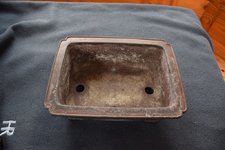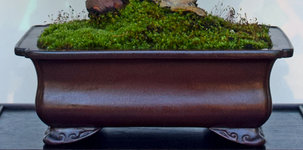You are using an out of date browser. It may not display this or other websites correctly.
You should upgrade or use an alternative browser.
You should upgrade or use an alternative browser.
Shinpaku
- Thread starter Toche
- Start date
Crazy Diamond
Omono
Very nice Shimpaku, how tall is it? have you ever thought in making it a bit smaller and compact in height like a shohin?
Shogun610
Masterpiece
You’re joking right ?Very nice Shimpaku, how tall is it? have you ever thought in making it a bit smaller and compact in height like a shohin?
Colorado
Masterpiece
Crazy Diamond
Omono
You’re joking right ?

Stella
Mame
o wow. this is such an incredibly beautiful tree. so much great inspiration
Thanks Stella, thanks Colorado,@Toche thanks for sharing! I enjoy viewing your trees and reading your commentary. And your English is very good!
Great Shinpaku. I like the rectangle container.
Well, this pot has a little story too.
When I went to Japan in 2018, I had the opportunity to visit several bonsai nurseries.
I saw, of course, many wonders, but I kept in mind the pot I was looking for for this tree.
I was lucky enough to find it when I visited the Yorozu-En nursery of Master Ayumu Fukano.
You could see that it had been used for many years, but I had no problem with that.
I was convinced that it was lime, so I thought I would clean it with vinegar to remove the white marks.





When I got back to the hotel, I left it in the bathtub overnight
Sensei Fukano had told me to sand it, I thought it would be sacrilege to sand a bonsai pot and I thought he was joking when he told me that.
When I got home to Belgium, I was in a hurry to clean the pot with vinegar.
First I used 6% vinegar, but without result, then I used 14% vinegar... Still no result.
I tried again with hydrochloric acid on a small piece on the bottom of the pot as a precaution, but no effect.
I thought about what Mr. Fukano had told me and I tried with water sandpaper with a very fine grain and I got the first encouraging results.
Then I tried on the bottom of one side of the pot because I was always afraid of damaging it.
Little by little, the pot "came back to life", I sanded it for hours on all sides with paper with finer and finer grains and always with water to obtain this result.

It became very, very soft, as if the clay used to make this pot was a terra sigillata.
It was so soft that I wondered if it was too soft to put a juniperus in.
I felt like I had a Bigei (Hirata Atsumi) pot in my hands.
I still wanted to give it a try, today, time is taking its toll, the patina is slowly coming back, it will still take a long time to get a wabi-sabi effect and a complete harmony with this tree, but I'm in no hurry
Today, I think that these white marks were due to the fertilizers and phytosanitary products given over the years.
If they were lime marks, they would have gone away with the acid, but there was no moss in reaction
I can never thank Master Fukano enough for his advice which seemed so crazy to me.
Cajunrider
Imperial Masterpiece
B
Beautiful treeI love my trees that have a story.
This one is a long story of friendship.
View attachment 402127
View attachment 402128
View attachment 402129
View attachment 402130
View attachment 402132
View attachment 402133
View attachment 402134
Bu-Jetjet
Mame
Thanks for this very informative story!Thanks Stella, thanks Colorado,
Well, this pot has a little story too.
When I went to Japan in 2018, I had the opportunity to visit several bonsai nurseries.
I saw, of course, many wonders, but I kept in mind the pot I was looking for for this tree.
I was lucky enough to find it when I visited the Yorozu-En nursery of Master Ayumu Fukano.
You could see that it had been used for many years, but I had no problem with that.
I was convinced that it was lime, so I thought I would clean it with vinegar to remove the white marks.
View attachment 402435
View attachment 402437
View attachment 402439
View attachment 402440
View attachment 402441
When I got back to the hotel, I left it in the bathtub overnightto do a first cleaning, the dirt was gone, but as I expected, the white marks were still there.
Sensei Fukano had told me to sand it, I thought it would be sacrilege to sand a bonsai pot and I thought he was joking when he told me that.
When I got home to Belgium, I was in a hurry to clean the pot with vinegar.
First I used 6% vinegar, but without result, then I used 14% vinegar... Still no result.
I tried again with hydrochloric acid on a small piece on the bottom of the pot as a precaution, but no effect.
I thought about what Mr. Fukano had told me and I tried with water sandpaper with a very fine grain and I got the first encouraging results.
Then I tried on the bottom of one side of the pot because I was always afraid of damaging it.
Little by little, the pot "came back to life", I sanded it for hours on all sides with paper with finer and finer grains and always with water to obtain this result.
View attachment 402432
It became very, very soft, as if the clay used to make this pot was a terra sigillata.
It was so soft that I wondered if it was too soft to put a juniperus in.
I felt like I had a Bigei (Hirata Atsumi) pot in my hands.
I still wanted to give it a try, today, time is taking its toll, the patina is slowly coming back, it will still take a long time to get a wabi-sabi effect and a complete harmony with this tree, but I'm in no hurry
Today, I think that these white marks were due to the fertilizers and phytosanitary products given over the years.
If they were lime marks, they would have gone away with the acid, but there was no moss in reaction
I can never thank Master Fukano enough for his advice which seemed so crazy to me.
Similar threads
- Replies
- 38
- Views
- 3K
- Replies
- 5
- Views
- 2K
- Replies
- 25
- Views
- 3K









